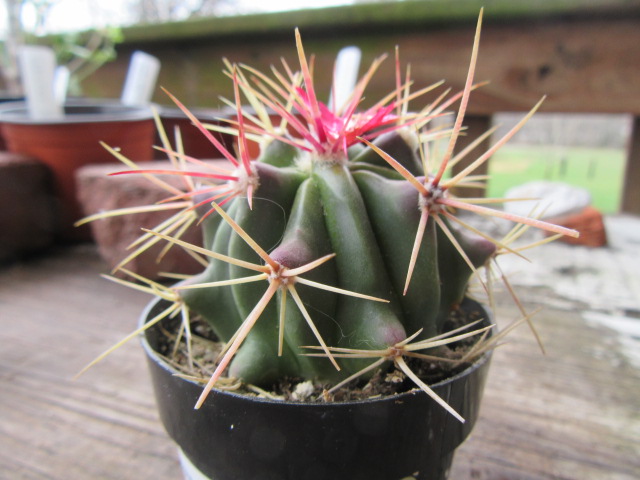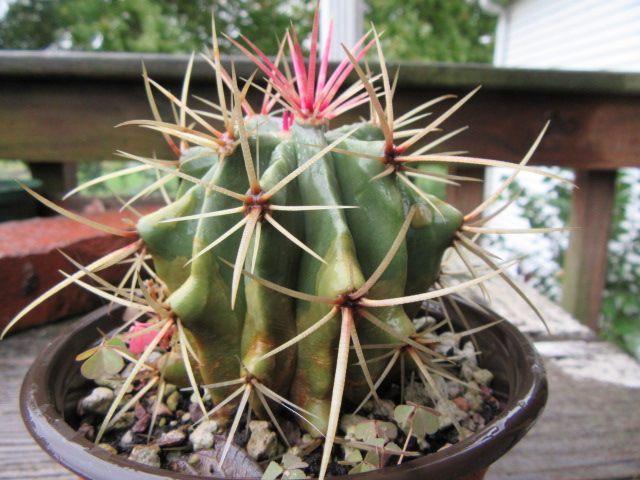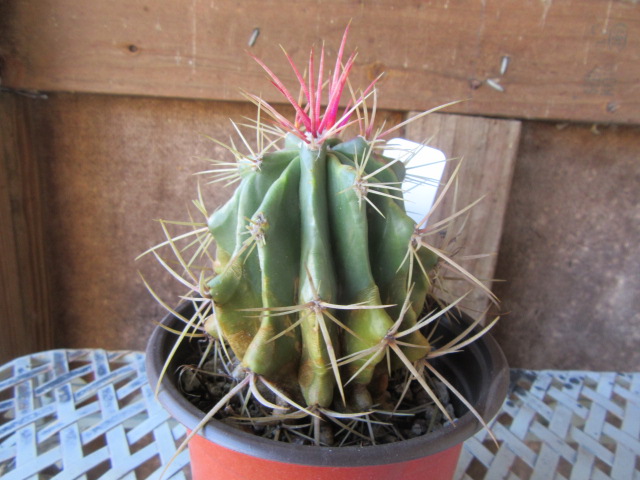
Ferocactus wislizeni (Fishhook Barrel Cactus) on 3-30-19, #557-11.
Arizona Barrel Cactus, Candy Barrel Cactus, Southwestern Barrel Cactus, Fishhook Barrel Cactus, Biznaga de Aqua
Ferocactus wislizeni
fer-oh-KAK-tus wis-LIZ-en-ee
Syn.
Echinocactus wislizeni
Synonyms of Ferocactus wislizeni: (18) (Updated on 12-7-23 from Plants of the World Online): Echinocactus arizonicus R.E.Kunze (1909), Echinocactus falconeri Orcutt (1902), Echinocactus wislizeni Engelm. (1848), Echinocactus wislizeni var. albispinus Toumey (1895), Echinocactus wislizeni f. albispinus (Toumey) Schelle (1926), Echinocactus wislizeni var. albus Costantin & Poiss. (1907), Echinocactus wislizeni var. decipiens Engelm. (1878 publ. 1879), Echinocactus wislizeni var. latispinus Schelle (1907), Echinocactus wislizeni f. phoeniceus (R.E.Kunze) Schelle (1926), Echinocactus wislizeni var. phoeniceus R.E.Kunze (1913), Ferocactus arizonicus (R.E.Kunze) Orcutt (1926), Ferocactus falconeri (Orcutt) Orcutt (1926), Ferocactus phoeniceus (R.E.Kunze) Orcutt (1926), Ferocactus wislizeni subsp. ajoensis Fencl & Kalas (2013), Ferocactus wislizeni var. ajoensis Fencl & Kalas (2012), Ferocactus wislizeni var. albispinus (Toumey) Y.Itô (1952), Ferocactus wislizeni var. flalconeri (Orcutt) Y.Itô (1981)(not validly publ.), Ferocactus wislizeni var. phoeniceus (R.E.Kunze) Y.Itô (1952)
Ferocactus wislizeni (Engelm.) Britton & Rose is the accepted scientific name for this species of cacti. It was named and described as such by Nathaniel Lord Britton and Joseph Nelson Rose in Cactaceae in 1922. It was first named Echinocactus wislizeni by Georg (George) Engelmann. The International Plant Names Index says the name was published in Wislizeni Tour North Mexico 96. Tropicos says it was published in Memoir of a Tour to Northern Mexico in 1848 and includes Friedrich Adolph Wislizenus as the in-author. The tour was connected with Col. Doniphan’s Expedition in 1846 and 1947.
The genus, Ferocactus Britton & Rose, was also named and described by Mr. Britton and Mr. Rose in the same publication as the species.
As of 12-7-23 when this page was last updated, Plants of the World Online lists 30 accepted species in the Ferocactus genus. It is a member of the plant family Cactaceae with 150 genera. That number could change as updates are made.
THERE ARE SEVERAL LINKS AT THE BOTTOM OF THE PAGE FOR FURTHER READING.

Ferocactus wislizeni (Fishhook Barrel Cactus) on 3-30-19, #557-12.
I brought this Ferocactus wislizeni home from Lowe’s on March 29 (2019). It was one of those “Strawflowers” from Altman Plants with the fake flower hot glued to the top. I managed to find three other cacti to bring home that didn’t have a strawflower.
The plant was in a 4 oz. (2 1/2” diameter x 2 1/4” tall) pot. The plant was approximately 1 5/8″ tall x 2 1/8” wide without the spines. The label states (along with the name being misspelled):
“Ferocactus wislizenii is native to the deserts of Texas, Arizona, Baja California, and Mexico. It is believed that the spines were used in the past as fishhooks. The flowers are variable; usually yellow to a beautiful, glowing deep orange. Protect from frost to prevent scarring.”

Ferocactus wislizeni (Fishhook Barrel Cactus) on 3-30-19, #557-13.
This plant was very small but in the wild, they grow HUGE and are very long-lived (up to 130 years). They have a tendency to lean south toward the equator which apparently led to one of its common names, Compass Barrel Cactus.
USEFUL INFORMATION:
Family: Cactaceae
Origin: Texas, Arizona, Southern California, Mexico
Zones: USDA Zones 9a-11 (20-40° F)
Size: Hmmm…
Light: Sun to part shade
Soil: Very well-draining soil. Potting soil amended with pumice or chicken grit and perlite.
Water: Regular watering during the summer. Very little, if any, during the winter.

Ferocactus wislizeni (Fishhook Barrel Cactus) on 6-8-19, #585-4.
On June 8 I noticed this cactus doing something weird. For a minute I thought it was growing three apexes but I realized it was just growing. As the plant was growing taller it was producing three new tubercles at the same time. Thank goodness the hot glue stuck to the spines finally came off without any damage to the plant.

Ferocactus wislizeni (Fishhook Barrel Cactus) on 6-19-19, #592-18.
Ferocactus wislizeni has 28-30 ribs, occasionally spiraled. Ribs become less prominent with regular watering during the summer and more so during the winter with no water.
Areoles produce up to 4 central spines and 12-20 variable radial spines. This is a very small plant now, but the spines are supposed to form a dense covering and the central spines will recurve.

Ferocactus wislizeni (Fishhook Barrel Cactus) at 2 1/4″ tall x 2 1/2″ wide on 10-11-19, #639-31.
I had to move the potted plants inside for the winter on October 11 because an “F” was in the forecast. As always, I photograph the potted pants and measure the cactus and some of the succulents when I bring them inside. The Ferocactus wislizeni measured 2 1/4″ tall x 2 1/2″ wide. That’s pretty good since it was 1 5/8” tall x 2 1/8” wide when I brought it home on March 29.

Ferocactus wislizeni (Fishhook Barrel Cactus) from the top on 10-11-19, #639-32.
I really like this cactus with its unusual ribs and the purplish color on top. I also like the prominent red color of the spines on top of the plant.
<<<<2020>>>>

Ferocactus wislizeni (Fishhook Barrel Cactus)at 2 3/8″ tall x 2 3/8″ wide on 10-15-20, #747-34.
I had to move the potted plants inside for the winter on October 15 because a “F” was in the forecast. As always, I took photographs and measurements as I brought them inside. The Ferocactus wislizeni measured 2 3/8″ tall x 2 3/8″ wide (not including the spines). I like the reddish glow.
<<<<2021>>>>

Ferocactus wislizeni (Fishhook Barrel Cactus) at 2 1/2′ tall x 3″ wide on 10-28-21, #853-8.
I didn’t have to move the potted plants inside for the winter until October 28 in 2021. When I moved the cactus inside the Ferocactus wislizeni had grown to 2 1/2″ tall x 3″ wide. This plant isn’t looking so well… Signs of fungal infections perhaps…
<<<<2022>>>>

Ferocactus wislizeni at 3 1/8″ tall x 3″ wide on 10-15-20, #737-34.
The potted plants had to be moved inside for the winter on October 15 in 2022. I put the cacti on the front porch with the succulents in 2022 and they did quite well. Some of the cacti really didn’t seem to like the full sun on the back porch, so I thought I would give them a little shade. The Ferocactus wislizeni did very well and grew to 3 1/8″ tall but it was still 3″ wide. That’s very good despite a little neglect.
Information online says these plants need plenty of water during their active growth cycle but not to get their “bodies” wet while in direct sunlight. LLIFLE says, “A wet cactus in the sunlight can cause sun burning which can lead to scars or even fungal infections and death.” Well, I never water any of my plants when the sun is on them… What is a person supposed to do If it rains in the morning and the sun comes out in the afternoon?
<<<<2023>>>>

Ferocactus wislizeni (Fishhook Barrel Cactus) at 3 3/4″ tall x 3″ wide on 10-23-23, #967-15.
Even though there was no “F” in the forecast until October 30, it was going to be a rainy week so I moved the potted plants inside on the 23rd and 24th. Time for photos and measurements…
The Ferocactus wislizeni did very well during the summer on the back porch in full sun despite the heat and drought. It measured 3 3/4” tall x 3″ wide when I moved it inside for the winter

Ferocactus wislizeni (Fishhook Barrel Cactus) from the top on 10-23-23, #967-16.
I will continue adding more photos and information as time goes by.
You can read my Cactus Talk & Update and Cactus & Succulent Tips to get my opinion about growing cactus and succulents.
If you would like more information about this cactus, click on the link to Llifle (Encyclopedia of Living Forms) below.
I hope you enjoyed this page and maybe found it useful. I would like to hear from you if you have any comments, questions, or suggestions. Please click on “like” if you visited this page. It helps us bloggers stay motivated. 🙂 You can check out the links below for further reading. The links take you directly to the genus and species of this plant.